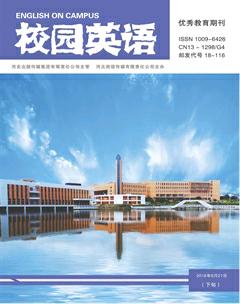A Study on Indirect Speech Act Theory in English Teaching andLearning
【Abstract】The indirect speech act theory provides a new perspective for teaching discourse. This paper first tries to briefly describe the expressing forms and functions of Indirect Speech Act Theory in communication. Meanwhile it can provide enlightenment for foreign language teaching, thus teachers can help language learners to improve their language communicative competence.
【Key words】Indirect Speech Act; English teaching and learning; expressing forms
1. Introduction
Speech act theory, proposed by John L. Austin and developed by John R. Searle, is one of the theoretical foundations for the communicative language teaching approach. Indirect speech act is the indirect phenomenon in our daily life that we can find that we often use it in communication and teaching. Indirect Speech Act theory and the communicative language teaching approach have something in common that both of them focus on the use of language rather than the knowledge of language.
This paper includes four parts, introduction, performance, application in teaching, and suggestions. Through discussing form of expression and function of indirect speech act theory, we can attempt to give some suggestions about it in English teaching and learning.
2. The performance and role of Indirect Speech Acts
2.1 The performance of speech acts by logic semantics
That is, declarative sentences express“statement”, interrogative sentences express “Ask”, the imperative expresses “order”, which express “propositions behavior” directly. Such as:
Amy asks Smith. (Statement)
Amy asks Smith? (Ask)
Amy, asks Smith! (Command)
The three sentences have the same position, but the function of behavior is different.
2.2 The performance of speech acts by Syntactic structure
Speaker use syntactic structure to cross the literal expression for expressing an indirect speech act. Interrogative sentence structure expresses indirectly “request”, “order” and other speech acts; declarative sentence structure expresses indirectly “advise”, “promise” and other speech acts; imperative sentence structure expresses indirectly “warning”, “compromise” and other speech acts. For example:
Can you pass the book over? (Request)
I would like you to write this down. (Order)
3. Application
As we all know, the goal of foreign language is to develop the learners communicative competence, which includes language ability and pragmatic competence. In order to improve their communicative skills to make sure they can understand and master the indirect language in English correctly, I think we should do following points:endprint
3.1 Improve teachers double culture competence
As a foreign teacher, not only master the proper use of native language for communication, but know the proper use of foreign cultures and language. Teachers in teaching language not only explain forms of language and its literal meaning, but also interpret the pragmatic functions of different forms of language and use the context. In this way, students can have opportunities to practice and use these language forms.
3.2 Enable students comprehension of indirect speech acts
In order to help students decrease errors in their indirect communication, we need to ask them to know the relationship between form and function, shallow structure and deep structure, literal meaning and intention of speakers. Therefore, we should emphasis the same speech act can be expressed by different sentences in English teaching, and the same sentence can express different speech acts, in order to make students can use English to express their intentions skillfully.
4. Conclusion
For a long time, our English teaching and learning concerns and emphasizes more on explaining grammar rules and language point occurring in course books. As a result, the students are only competent in grammar but incompetent in communication. This paper aims to increase the students pragmatic knowledge and awareness in the perspective of indirect speech act theory, which may serve as guiding principle in communicating appropriately. With the guide of the indirect speech act theory, both the English teachers and students may get out of the impasse of inefficient listening and reading, speaking and writing.
References:
[1]Austin,J.L.How to Do Things With Words[M],Oxford:Oxford University Press,1962.
[2]Bach,K and Harnish,R.M,Linguistics Communication and speech Acts,Cambridge[M],Mass:MIT Press,1979.
[3]Levinson,S.C.Pragmatics[M].Cambridge:Cambridge University Press,1983.
作者简历:李倩倩(1991.02.14-),女,汉族,山西晋城人,硕士,研究方向:学科教学英语。endprint

